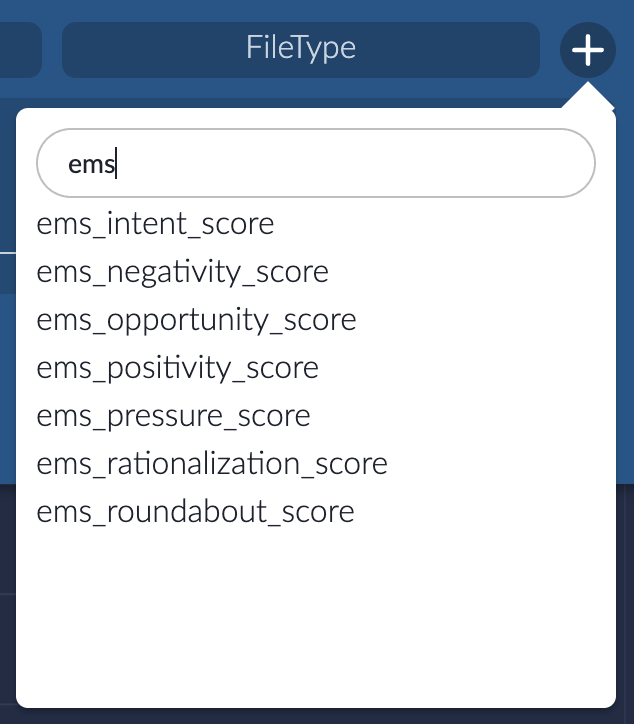Overview
Emotional Intelligence, also known as Sentiment, uses natural language processing tools to analyze the emotional content of document text, then assigns it a score between 0 and 10. These scores are calculated automatically when new datasets are ingested and appear in the Document View metadata. There are 7 types of Emotional Intelligence scores:
Sentiment | Database Field | Description |
|---|---|---|
Intent | ems_intent_score | Someone’s intention or purpose; “I will do this.” |
Negativity | ems_negativity_score | Content where people discuss negative things, which can lead to discovering conversations about problems. |
Opportunity | ems_opportunity_score | Circumstances making it possible for someone to do something; “I can do this.” |
Positivity | ems_positivity_score | Content that tends towards the positive and optimistic. |
Pressure | ems_pressure_score | Attempts to persuade, influence, intimidate; “You must do this.” |
Rationalization | ems_ratioalization_score | Attempts to explain or justify; “It’s okay to do this because…” |
Roundabout Style | ems_roundabout_score | Situations where someone is being evasive or attempting to avoid the truth, perhaps through unusually wordy conversations or avoiding to address a point directly. |
The 0–10 scale can be interpreted as follows:
Neutral (0): Documents that don’t lean towards any of the 7 sentiments, such as numerical spreadsheets, programming code, or bland correspondence.
Low (1, 2, or 3): Documents scored that contain mild levels of a sentiment.
Medium (4, 5, or 6): Documents scored that contain moderate levels of a sentiment.
High (7, 8, 9, or 10): Documents scored that contain high levels of a sentiment.
To apply Emotional Intelligence scoring to datasets created before v7.2.0, simply rebuild your dataset; documents will be automatically scored and indexed without needing to change any settings.
Using Emotional Intelligence for Search and Sorting
Sentiment is critical to understanding an individual’s emotion, intent, and awareness in their digital communications. It can help to better understand the emotional circumstances leading to the formulation of an idea, the framing of a statement, or the initiation of an action. This leads to insights into what motivated people to act as they did.
Brainspace allows you to incorporate Emotional Intelligence in these ways:
Advanced Searches
After clicking the “+” sign when performing an advanced search, type in a sentiment using its database field.

Using the search dropdown, you can select between a single score or a score range.
.png)
After typing your score or range, click “search” to filter your results.
Sorting Documents by Metadata Field
To filter documents by sentiment type, select that type in the dropdown or type in its database field. Click the arrow to the right of the search bar to change from descending score order (10–0) to ascending (0–10).
.png)
See Document Viewer for instructions on how to turn search results into a focus or notebook.
Retrieving a Document’s Score(s)
To the left of Document Viewer, find a document’s Emotional Intelligence scores by searching for its field in the search bar.
.png)
Language Capabilities
Brainspace supports sentiment analysis in various languages depending on the Emotional Intelligence category.
Positivity and Negativity are supported in English, Arabic, French, Japanese, Persian, and Spanish.
Intent, Opportunity, Pressure, Rationalization, and Roundabout Style are supported in English, Chinese, German, Japanese, Korean, Portuguese, and Spanish.